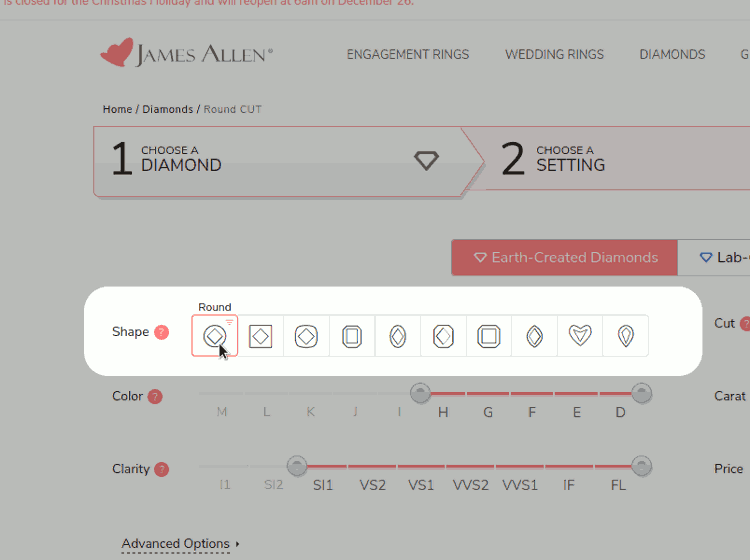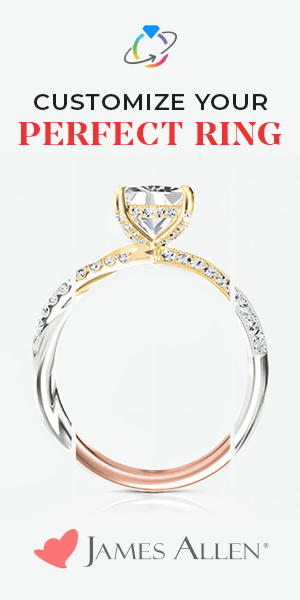
The Low Down On Getting The Biggest Diamond For Your Money
How To Get The Maximum Carat Weight On A Limited Budget
Here's what we're going to do. We will see if we can find a nice looking diamond that is:
- Weight: 1 carat+
- Price Range: Under US$2000
- Shape: fancy cut
- Color: Near Colorless to Faint
A Buying Guide When Shopping Engagement Rings at James Allen
If you want to know how to buy the best diamond for your money this article will show you.
How to Find A Big Cheap Diamond
So you want a big rock? A really really big rock? But don't want to pay through the nose? Well let's see if we can't find you big diamond at a decent price.
For the purposes of this exercise we are going to think outside the box a little and do away with some convention.
First of all we are going to look at all diamonds. Not just round diamonds. After all what we want to do here is get the most carat weight we can find for our money.
Go to:
Once you see the options page click on "Round" to deselect it. You will then be shown all diamond shapes, not just the round diamonds. So instead of selecting one shape we are deselecting all shapes, but this causes all shapes to display rather than none, which is good for us.
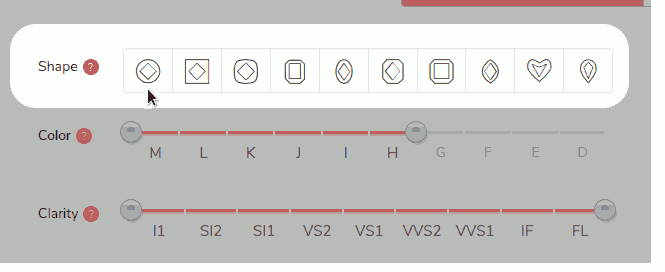
Round diamonds are not usually the cheapest when we are talking about cost-per-carat. So for this reason we are going to include all the other shapes. Shapes which are not round are called fancy cuts.
Next we are going to select all the colors. Since we want the biggest diamond for our budget we can't shy away from the "warmer" colors. Don't worry, we might still get a fairly colorless diamond. James Allen has built its reputation on having uniform photography of all its diamonds. This means that we can compare the color between diamonds onscreen and rest assured that the color represented on the screen will be an accurate comparison to other diamonds at James Allen. You can easily see if a diamond shows a lot of its color in comparison to other diamonds and can then choose the best diamond accordingly.
At the time of writing James Allen has fancy cut diamonds that range from D to K. Round cut diamonds at James Allen range from D to M. So you could perform this search by only including color grades K and up. Since we will be sorting the results by Price Low to High the L and M color diamonds won't show up until we scroll for quite a while. Round cut diamonds are a tad more expensive even when they are a lower color grade yet are the same weight as a fancy cut.
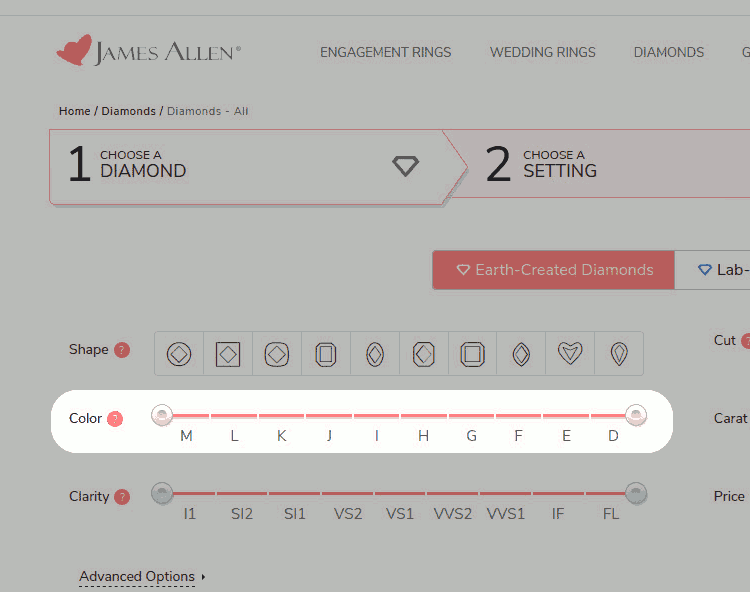
Go ahead and slide the color slider all the way to the left. Whether you want to show the higher color grades is up to you. But you decide where you want the cutoff. Maybe H, maybe G. Or leave all the colors selected. The screenshot above shows all colors selected. However I am going to be looking mostly among the I, J and K color diamonds.
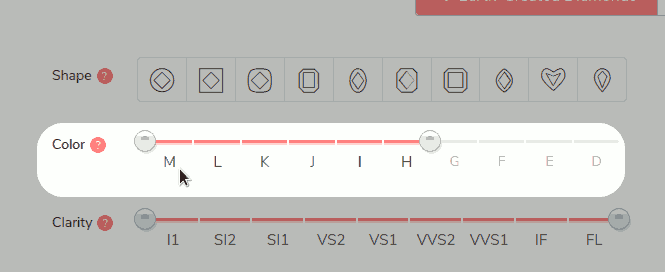
Following this you can select the clarity grades that you want to display. This is an area that scares a lot of people. But it's not as hard as you'd think. Since this tutorial is about how to find the biggest diamond for our money we are going to look at all the clarity grades. Yes it's true that the I1-SI2 clarity grades are for the most part not going to be eye clean. However is that really such a big deal? Remember inclusions are the fingerprint of a diamond. And a lot of the time they are barely noticeable. Yes the 20x magnification at James Allen shows you exactly what you are getting. But if you zoom out to the 1x image you can see that the inclusions vanish into infinitesimal points. OK the resolution on the screen isn't going to render the inclusions when zoomed out, but you can imagine that in actuality they are going to be very difficult to see unless you have super laser vision. So as long as the inclusions are not the main feature of the diamond you will be fine. Of course if for cultural reasons everyone around you associates clarity with purity, well you'll probably have to consider sliding the left slider over a few notches to the right.
In order to find a big rock we are going to include the lowest clarity grade which at James Allen is I1.
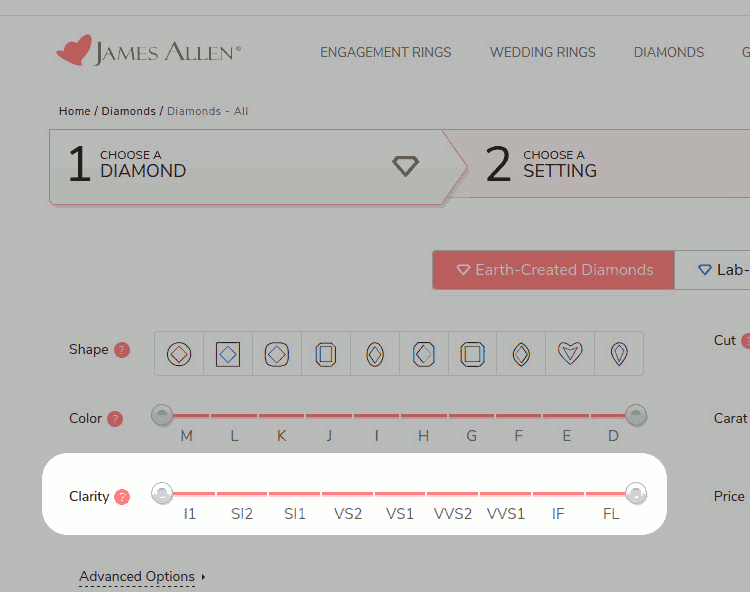
The cut grade is always heralded to be the most important factor when choosing a diamond. This is true. But here's a huge secret: Fancy cuts for the most part don't get given a cut grade. This means it is up to the vendor to give an estimate of the cut grade. Can we somehow find an excellent cut diamond that doesn't have an excellent cut grade on its diamond certificate? You may be surprised by the answer. Keep reading as I will show you how to take advantage of James Allen's photos to make your own assessment of a diamond's light performance. For now suffice it to say that allowing all cut grades to show in the search results is ok, and will help us in finding a bigger rock. Having all color grades included is important as you will see very soon.
Select all the cut grades, as we don't want to leave any diamonds out.
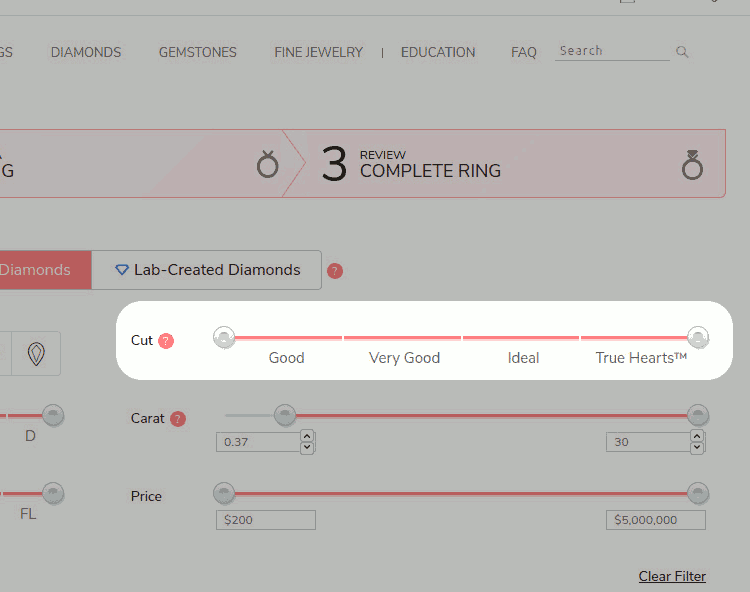
Since this guide is about finding the biggest diamond for our money within the aforementioned price range we can set the minimum weight at 1 carat.
We'll leave the top end at the maximum carat weight but this budget won't let us see much more above 1.4 ct displayed. The majority of the results will be fancy cut diamonds. The few round diamonds that do show up are not going to be ones I would recommend. For a half way decent round diamond the budget will have to be increased. The best looking diamonds that will be brought up by this search will be the princess cut diamonds followed by emerald cut, heart cut, cushion cut and
Slide the marker to the desired carat weight of 1 carat or type in 1 in the left hand field and hit enter or click anywhere outside the field for the results to update. -- You can also hit tab on your keyboard to jump to the next field.
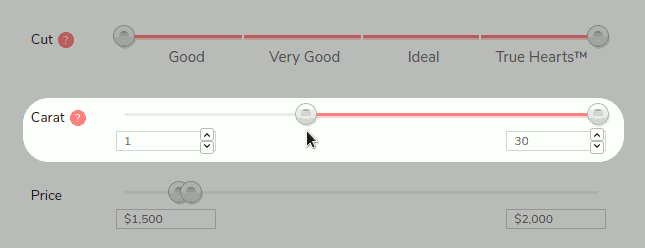
For the budget of course you can set it at whatever level you want. As this article is about showing how it is possible to find a good 1 ct diamond at a decent price I won't include diamonds over US$2000.
For this exercise we are keeping the budget for the diamond below US$2000. Anything below US$1600 is going to be very included. So there's not much point looking among the diamonds under that price level. But that's ok, because we are working with a US$2000 diamond budget anyway.
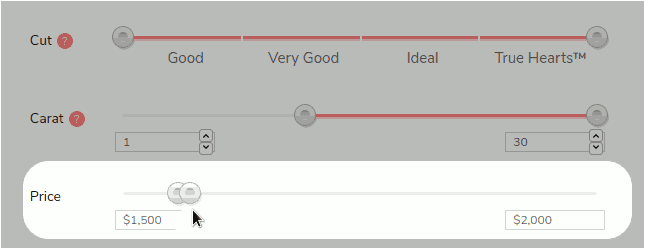
Now is where the fun begins. This part really appeals to the hunter gatherer in us as we are presented with several hundred diamonds to pore over. My search brought up 497 diamonds.
If we sort the diamonds by cut grade we are shown the princess cut diamonds first as those are the only ones that have a cut grade assigned to them. This is only due to the fact that the GIA hasn't started offering cut grades for fancy cuts apart for princess cut diamonds. AGS does offer them, but not many manufacturers want to assign a cut grade to fancy cuts as they can hardly ever shine as bright as round brilliants. Anyway as you will see there are some fairly decent princess cut diamonds that show up using the parameters we are using here.
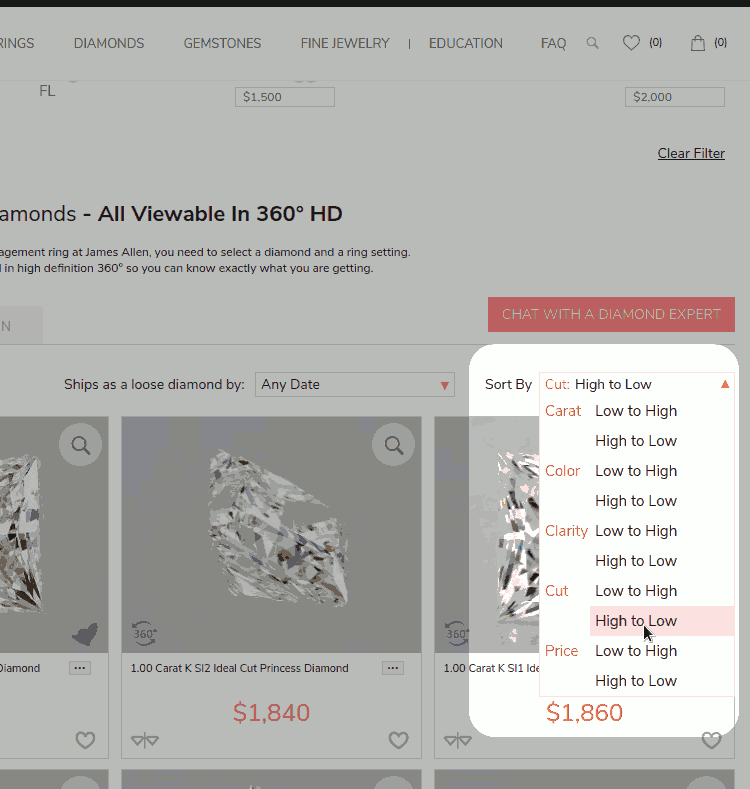
You may be wondering why I didn't simply suggest looking at princess cut diamonds. After all the best ones here seem to all be princess cut diamonds. Well for two reasons. First of all there may be another shape that appeals to you more. There are some great emerald cuts that show up in this search. But the second reason is that I want to show you how well princess diamonds conceal their color. Diamonds do not have mixed colors. Any color gradient you see are all the result of light return being stronger in certain parts of the diamond. The goal of a diamond cutter is to cut a diamond in such a way for light to be returned to the eye when the diamond is held at a comfortable distance. This is about 25 to 40 cm from one's eyes. As each of the facets acts as both a window and a mirror, diamonds can perform some amazing feats when it comes to light play. So if you look at the K diamonds which are not princess cuts you can see that in some parts they look quite colorless. I am talking in particular about the oval, pear, and marquise cuts. These shapes (oval, pear, and marquise) offer us a practical education in light performance. It's also why those shapes look much better when they are completely colorless.
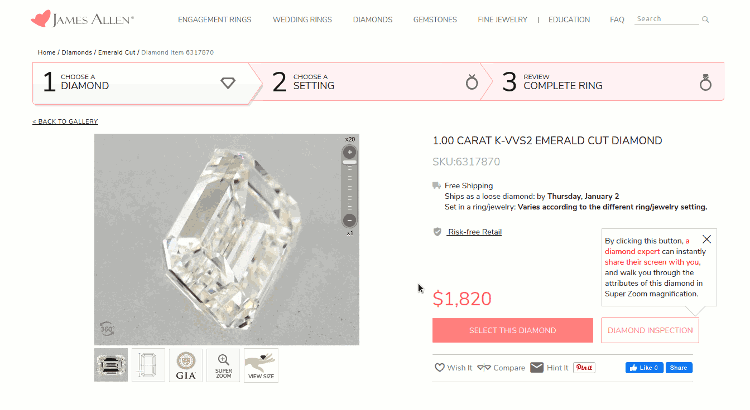
Emerald cuts actually look quite good when they are a warmer color as they have different properties to other shapes that make them attractive. Emerald cuts are much nicer if they are from higher clarity grades like VVS1 and VVS2 or even IF. My search in this example did bring up one such diamond. Emerald cuts are quite popular at the moment, so this could be a viable choice.
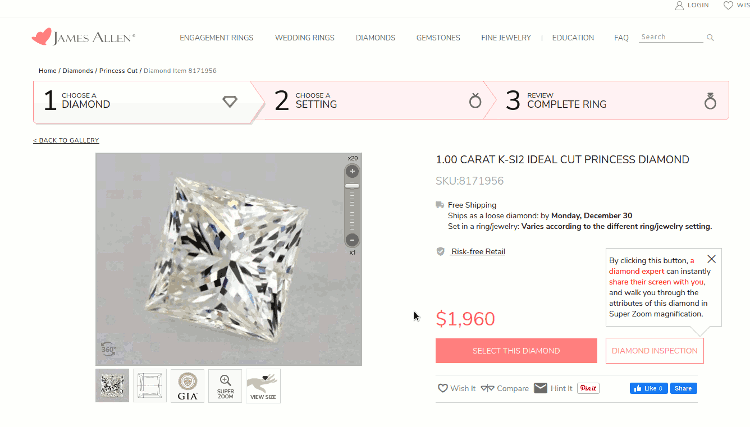
The search also brings up a very nice princess cut diamond. The fact that this K diamond isn't showing its color is due to the fact that it has good light return. And even though it has an SI2 clarity grade the inclusion which gives it this grade is not black so it's not going to be too noticeable.
So there you have it. A step by step guide on choosing a 1 carat diamond under US$2000. The main compromise had to be in the color grade and we had to look among the more included diamonds. But as you can see it's not impossible and you will find a diamond the wearer will be proud to possess.
Want a shortcut?
Here is a prefilled search query I created that will return a current list of James Allen diamonds sorted by cut grade along all of the parameters I mentioned above:
